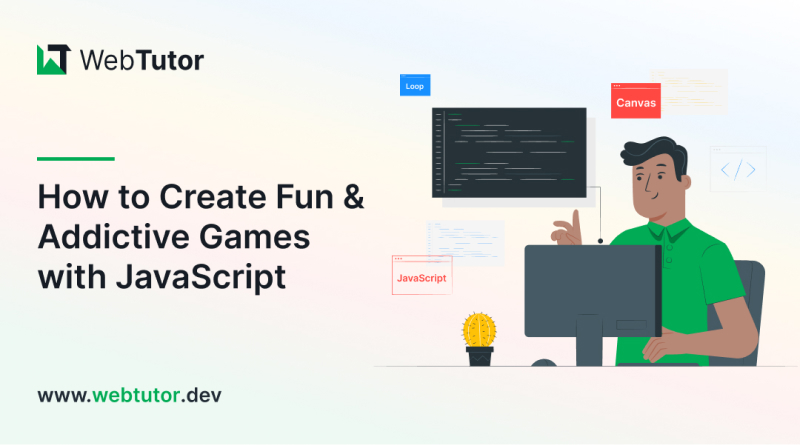JavaScript has become one of the most popular programming languages for game development in recent years. With its versatility and ease of use, it has opened up a world of possibilities for both novice and professional game developers.
In this blog, we will take a deep dive into the exciting world of JavaScript game development and show you how to create fun and addictive games like a boss!
Why Choose JavaScript for Game Development?
When it comes to game development, JavaScript offers a wide range of advantages.
Versatility
First and foremost, it is a versatile and powerful programming language that is supported by all major web browsers. This means that your games can be easily accessed and played by users on different platforms, including desktop and mobile devices.
Simple to Use
Another reason to choose JavaScript for game development is its simplicity. The syntax of JavaScript is quite similar to other programming languages like C++ and Java, making it easy for developers to learn and use.
Large and Active Community
Additionally, JavaScript has a large and active community, which means you can always find support and resources to help you along your game development journey.
Basics of JavaScript Game Development
Before diving into the world of game development, it's important to understand the basics of JavaScript.
JavaScript is a scripting language that runs on the client side, meaning it is executed by the user's web browser. It is mainly used for adding interactivity and dynamic content to websites, but it can also be used to create full-fledged games.
To get started with JavaScript game development, you will need a basic understanding of HTML and CSS.
HTML is used to structure the content of your web page, while CSS is used to style and layout the elements.
JavaScript is then used to add interactivity and functionality to your game.
Setting Up Your Development Environment
To start developing JavaScript games, you will need a development environment that allows you to write and test your code. There are several options available, but one of the most popular choices is Visual Studio Code.
It is a lightweight and powerful code editor that offers a wide range of features for JavaScript development.
Install the Live Server Extension
Once you have installed Visual Studio Code, you will also need to install the Live Server extension. This extension allows you to run your game in a local server environment, which makes it easier to test and debug your code.
To install the Live Server extension, simply open Visual Studio Code, go to the Extensions tab, and search for "Live Server".
Understanding Game Loops and Animations
In game development, a game loop is a continuous process that updates and renders the game state. It is responsible for handling user input, updating the positions of game elements, and rendering the game graphics. Understanding game loops is crucial for creating smooth and responsive games.
JavaScript provides several methods for creating game loops, but one of the most commonly used approaches is the requestAnimationFrame() method.
This method tells the browser that you want to animate a specific function and requests that the browser calls this function before the next repaint.
To create animations in JavaScript games, you can use the HTML5 Canvas element.
The Canvas element provides a drawing surface on which you can dynamically render graphics, images, and animations.
By combining the requestAnimationFrame() method with the Canvas element, you can create visually stunning and interactive games.
Creating Game Elements and Characters
Now that you have a solid understanding of the basics, it's time to start creating game elements and characters.
In JavaScript game development, game elements refer to objects that make up the game world, such as platforms, obstacles, and power-ups. Characters, on the other hand, are the entities controlled by the player, such as the main character or enemies.
To create game elements and characters in JavaScript, you can use the HTML DOM (Document Object Model) manipulation methods. The DOM is a programming interface for HTML and XML documents, which allows you to dynamically create, modify, and delete elements on a web page.
For example, to create a platform in your game, you can use the createElement() method to create a new HTML element, set its properties and attributes, and append it to the game world. Similarly, you can create characters by creating new HTML elements and attaching event listeners to handle user input.
Adding Interactivity and User Input
Interactivity is a key aspect of any game, as it allows players to engage with the game world and control the characters.
In JavaScript game development, you can add interactivity by handling user input events, such as mouse clicks, keyboard presses, and touch gestures.
To handle user input events in JavaScript, you can use event listeners. An event listener is a function that is called when a specific event occurs, such as a button click or a key press.
By attaching event listeners to specific elements in your game, you can respond to user input and trigger actions accordingly.
For example, to move a character in response to keyboard input, you can add a keydown event listener to the window object. When the user presses a key, the event listener function will be called, and you can update the character's position based on the input.
Implementing Game Logic and Rules
Game logic and rules define how the game world behaves and how the characters interact with each other. In JavaScript game development, you can implement game logic by writing functions that handle the game state and perform calculations based on the user input and game elements.
For example, if you are creating a platformer game, you can write a function that checks for collisions between the main character and the platforms. If a collision is detected, you can update the character's position and apply the appropriate physics to simulate jumping or falling.
To implement game rules, you can use conditional statements and loops. Conditional statements allow you to define different paths of execution based on specific conditions, while loops allow you to repeat a block of code until a specific condition is met.
Designing Game Levels and Challenges
Game levels and challenges are what make a game interesting and engaging. In JavaScript game development, you can design game levels by creating different layouts, setting up obstacles and enemies, and defining the goals and objectives.
To design game levels in JavaScript, you can use arrays to represent the game world. An array is a collection of elements, and each element can represent a specific tile or object in the game. By manipulating the elements of the array, you can create different level layouts and add variations to the gameplay.
To make the game challenging, you can introduce enemies with different behaviors and abilities.
For example, you can create enemies that move in a specific pattern, enemies that shoot projectiles, or enemies that follow the player's movements. By adding these challenges, you can keep the players engaged and motivated to progress through the game.
Optimizing Performance and Handling Game Assets
As your JavaScript game becomes more complex, it's important to optimize its performance and handle the game assets efficiently. Performance optimization involves improving the speed and responsiveness of the game, while asset handling involves managing and loading game resources, such as images, sounds, and animations.
To optimize the performance of your JavaScript game, you can use techniques like code profiling, caching, and minimizing the use of heavy computations. Code profiling allows you to identify bottlenecks and optimize the critical parts of your code, while caching allows you to store frequently used data in memory for faster access.
When it comes to handling game assets, you can use the HTML5 File API to load and manipulate files from the user's local system. This allows you to dynamically load images, sounds, and other resources into your game. Additionally, you can use third-party libraries and frameworks, such as PixiJS or Phaser, to handle asset loading and management more efficiently.
Testing and Debugging Your JavaScript Game
Testing and debugging are crucial steps in the game development process, as they help you identify and fix any issues or errors in your code. In JavaScript game development, you can use the browser's built-in developer tools to test and debug your game.
The developer tools provide a wide range of features for inspecting and manipulating the HTML, CSS, and JavaScript code of a web page. You can use the console to log messages and debug information, set breakpoints to pause the execution of your code, and inspect the values of variables and objects.
In addition to the browser's developer tools, you can also use testing frameworks like Jest or Mocha to write automated tests for your game. Automated tests allow you to simulate user interactions and verify that your game behaves as expected under different conditions.
Publishing and Sharing Your JavaScript Game
Once you have finished developing and testing your JavaScript game, it's time to publish and share it with the world. There are several ways to distribute your game, depending on your target audience and platform.
If you want to distribute your game as a web application, you can host it on a web server and provide a link to your game's URL. This allows users to access and play your game directly from their web browsers. You can also package your game as a Progressive Web App (PWA), which allows users to install and play your game offline.
Alternatively, you can publish your game on popular game distribution platforms, such as Steam or the App Store. These platforms provide a wide audience and offer features like monetization, analytics, and user reviews. To publish your game on these platforms, you will need to follow their specific guidelines and requirements.
Resources and Tools for JavaScript Game Development
JavaScript game development is a vast field with a wide range of resources and tools available. Whether you are a beginner or an experienced developer, there are plenty of tutorials, libraries, and frameworks to help you create amazing games.
One of the best resources for learning JavaScript game development is the Mozilla Developer Network (MDN). MDN provides comprehensive documentation and tutorials on JavaScript, HTML, and CSS, as well as examples and demos of game development techniques.
In addition to MDN, there are several online platforms that offer free and paid tutorials on JavaScript game development. Webtutor.dev is one such platform that provides a wealth of resources for learning JavaScript and game development. From beginner-friendly tutorials to advanced techniques, you can find everything you need to become a pro game developer.
Conclusion
In conclusion, JavaScript game development offers a fun and rewarding experience for both novice and professional developers. With its versatility and ease of use, JavaScript allows you to create fun and addictive games that can be played on different platforms.
By following the steps outlined in this article, you can sharpen your JavaScript skills and become a master game developer. So what are you waiting for? Start creating your own JavaScript games today and let your creativity soar!
Visit Webtutor.dev for free online JavaScript tutorials

